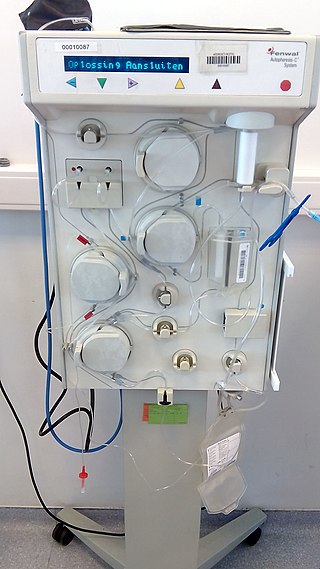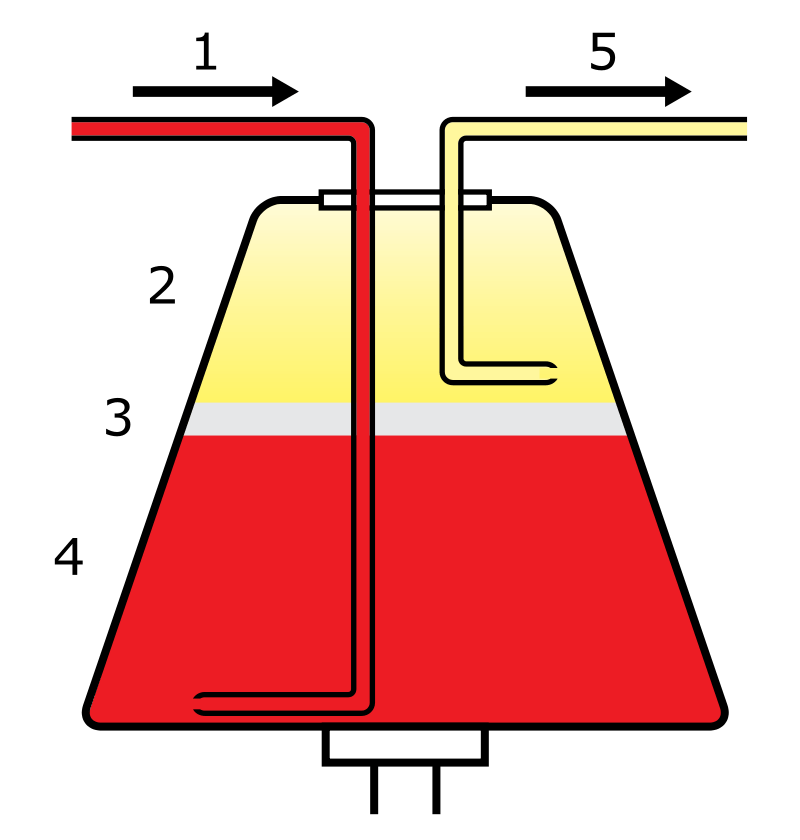What is the Difference Between Plasmapheresis and Plasma Exchange
Table of Contents
The key difference between plasmapheresis and plasma exchange is that plasmapheresis is a process in which the plasma is separated from the blood either by centrifugation or membrane filtration, while plasma exchange is a process that involves discarding the plasma totally and substituting it with replacement fluid.
Plasmapheresis and plasma exchange are two types of apheresis. Apheresis is a medical technology in which the blood of a person is passed through an apparatus that separates out particular constituents and returns the remainder to the circulation. Thus, it is an extracorporeal therapy. There are mainly two types of apheresis: donation (plasmapheresis, erythrocytapheresis, plateletpheresis, leukapheresis) and therapy (plasma exchange, LDL apheresis, photopheresis, leukocytapheresis, and thrombocytapheresis).
CONTENTS
1. Overview and Key Difference
2. What is Plasmapheresis
3. What is Plasma Exchange
4. Similarities – Plasmapheresis and Plasma Exchange
5. Plasmapheresis vs Plasma Exchange in Tabular Form
6. Summary – Plasmapheresis vs Plasma Exchange
What is Plasmapheresis?
Plasmapheresis is a process in which the plasma is separated from the blood either by centrifugation or membrane filtration. Plasmapheresis was originally described by doctors Vadim A. Yurevick and Nicolay Rosenberg of Imperial Medical and Surgical Academy of Saint Petersburg, Russia, in 1913. Moreover, Michael Rubinstein was the first to use plasmapheresis to treat an immune-related disorder when he saved the life of an adolescent boy with thrombotic thrombocytopenic purpura (TTP) at Cedar of Lebanon Hospital in Los Angeles, USA, in 1959. The modern plasmapheresis procedure originated at USA National Cancer Institute between 1963 and 1968.

Figure 01: Plasmapheresis
Plasmapheresis is useful in collecting the FFP (fresh frozen plasma) of a particular ABO group. The commercial uses of this procedure (aside from FFP) include immunoglobulin products, plasma derivatives, and the collection of rare WBC and RBC antibodies. Plasmapheresis can also refer to the plasma donation process where the plasma is removed, and the blood cells are again returned to the body. Plasmapheresis can be used to treat a variety of autoimmune diseases such as myasthenia gravis, Guillain Barre syndrome, chronic inflammatory demyelinating polyneuropathy, and Lambert Eaton myasthenic syndrome. It can also be used to treat certain complications of sickle cell disease and certain forms of neuropathy.
What is Plasma Exchange?
Plasma exchange is the technique of discarding the plasma totally and substituting it with replacement fluid. It involves the removal of the liquid portion of blood to remove harmful substances and replace it with a replacement solution. Then the removed plasma is discarded, and the patient receives the replacement donor plasma, albumin, or a combination of albumin and saline (normally 70% albumin and 30% saline). Therapeutic apheresis or plasma exchange is performed in such a way as to remove toxic elements from the bloodstream.

Figure 02: Plasma Exchange – (1) Whole blood enters the centrifuge and (2) separates into plasma, (3) leukocytes and (4) erythrocytes. (5) Selected components are then drawn off
In this procedure, a catheter is placed into a vein and connected to a machine via plastic tubing. Blood is pumped through the tubing into the machine, where it is separated into red blood cells, white blood cells, and plasma. Later, the plasma is discarded while the other components are combined with a plasma substitute (albumin and saline) and reinfused into the individual. Furthermore, plasma exchange can be used as a treatment for chronic rheumatic diseases.
What are the Similarities Between Plasmapheresis and Plasma Exchange?
- Plasmapheresis and plasma exchange are two types of apheresis.
- Both processes are linked to blood separation.
- They show therapeutic usage.
- Both processes can be used to treat numerous diseases.
- They are extremely important processes to safeguard people’s life.
What is the Difference Between Plasmapheresis and Plasma Exchange?
Plasmapheresis is a process in which the plasma is separated from the blood either by centrifugation or membrane filtration, while plasma exchange is the technique of discarding the plasma totally and substituting it with replacement fluid. Thus, this is the key difference between plasmapheresis and plasma exchange. Moreover, plasmapheresis is used for donor purposes as well as therapeutic purposes, while plasma exchange is used only for therapeutic purposes.
The below infographic presents the differences between plasmapheresis and plasma exchange in tabular form for side by side comparison.
Summary – Plasmapheresis vs Plasma Exchange
Plasmapheresis and plasma exchange are two types of apheresis processes. Plasmapheresis is a process in which the plasma is separated from the blood either by centrifugation or membrane filtration, while plasma exchange is the technique of discarding the plasma totally and substituting it with replacement fluid. So, this is the key difference between plasmapheresis and plasma exchange.
Reference:
1. “Plasmapheresis.” An Overview | ScienceDirect Topics.
2. “Plasma Exchange.” An Overview | ScienceDirect Topics.
Image Courtesy:
1. “Plasmapheresis” By Mǃdgard – (CC BY-SA 3.0) via Commons Wikimedia
2. “Apheresis” By Mononomic at English Wikipedia (CC BY-SA 3.0) via Commons Wikimedia
ncG1vNJzZmivp6x7pbXFn5yrnZ6YsqOx07CcnqZemLyue9ahmK1lmah6tbTEZpuinpaav6a6wp5km52krLKmuoypo5qrnZa9qbHRnqqiq12Wu6V5z6WYrKWRYrK5r8eapaCdXw%3D%3D